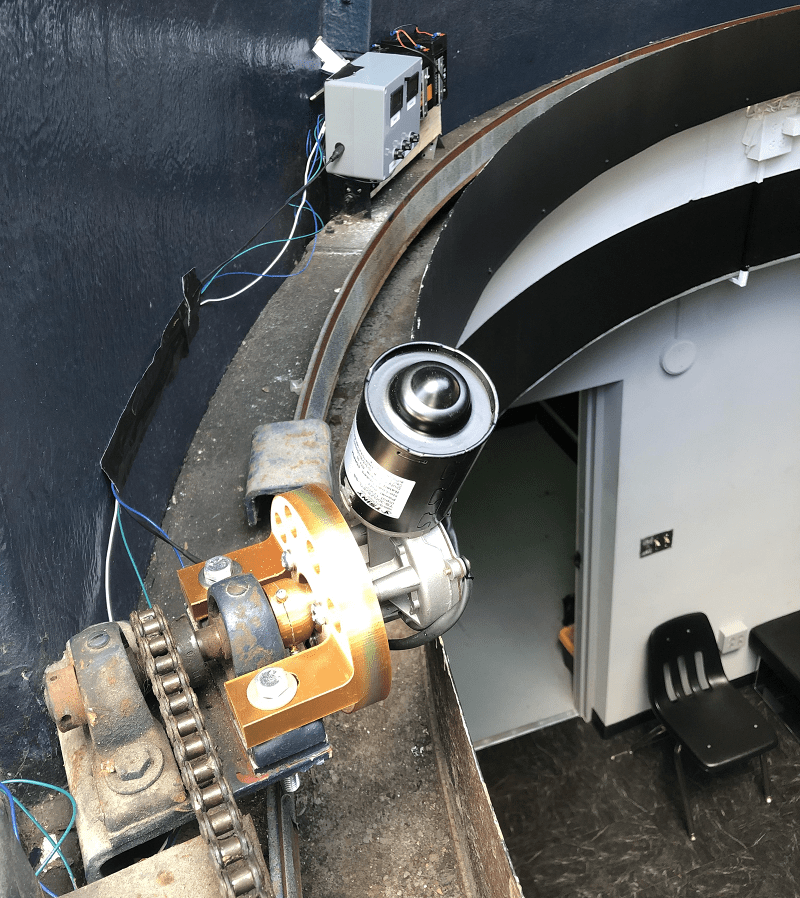The South Florida Science Center recently added a new ten-inch telescope and turned to [Andres Paris] and his brother to replace the hand-cranked dome door system. They turned to an Arduino along with some beefy motor drivers. You can see some videos of the beast in operation, below.
According to a Reddit post, the brothers picked up a 5A 12V motor but decided to overdesign and selected an H-bridge that would handle 20A peak current. An IR remote allows the operator to open and shut the door and reed switches sense the extremes of the door’s motion.
The second video shows the motor and the 3D printed coupling to the existing door gear train. Since the displays on the box are fairly bright, the operator can turn them off using the remote control.
It doesn’t look as thoug any code or diagrams are available, but we are guessing that this type of system would be custom for each individual case anyway. As it turned out, the moving of the existing gear train wasn’t the biggest problem, instead it was supplying the power.
Since the dome rotates, it was not possible to wire the box to power. The system uses some batteries that right now have to be manually charged. However, the brothers plan to take advantage of the fact that the dome is always put back to the same position so they can wirelessly charge the batteries using a Qi transmitter that lines up with the associated receiver when in the home position.
If you would like your own dome, we — along with the Wayback Machine — can help. We truly envy all of the people out there with no deed restrictions.















I wouldn’t say using a 20Apk controller on a 12Amotor is over designing. It would not be unreasonable for a 12A motor pull in excess of double that (24A) for short periods ie when starting or when stalled. A 20A peak controller would be about the minimum depending on what other protection methods were employed.
Well you are right it isn’t extreme, but they were 5A motors (12V) so it is 4X not 2X.
20A motor controller does seem “about right” maybe even rather smallish for the motor shown in the video. It’s definately not an “overdesign”. I wonder there that 5A specification comes from. DC motors can easily draw a peak current of 10x their nominal current during stall and startup.
Also: Nice setup, but it’s a pretty big building for such a small Telescope…
“but it’s a pretty big building for such a small Telescope…”
The dome is probably designed for the telescope they wish to have in there. Not the one they currently have. Thinking ahead ;)
Still the same point. You don’t want to stress the controller too much either in case it’s a) chinese, b) not properly heatsinked, c) running in a hot environment… etc. just like you wouldn’t build a computer with a power supply that was just enough.
Controlling a telecope was how the language FORTH, started by Charles H. Moore. It would be very RETRO, to have this sytem setup run by FORTH. A simple option would be to use the MikroForth by Georg Heinrichs. The previous version used the ATTINY2313 with a collection of documentation here – https://wiki.forth-ev.de/doku.php/en:attiny but he has added now the Arduino / nano version see http://www.g-heinrichs.de/wordpress/index.php/author/wordpress/ unfortunately mostly in German for now. The earlier version is as well avaiable as book in German and English at https://www.amazon.co.uk/gp/product/172662692X/ref=dbs_a_def_rwt_bibl_vppi_i5
Flip the design. Put the drive system in a fixed position on the base. Use rollers and gear teeth on dome. No worries about power.
this needs to open the shutters, not turn the dome
the cable installation is very dangerous! a tape against the dome?! put some cable pipes please!
Qi Charging for the battery? Just use a single sliding contact, its only 12-15v, and use the frame as ground.
tu as raison il y a une autre methode dans cette conception il est utile et moin risque et plus fiable que c’est petit truc que cera rien
https://thecurious605531859.wordpress.com/2020/07/14/remnant-of-a-missing-galaxy-discovered-near-the-sun/